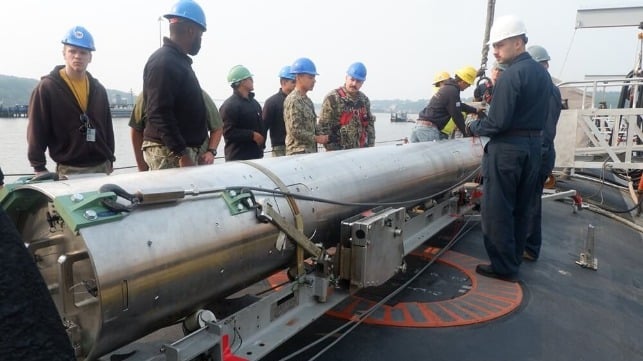US Navy Subs Are Getting a Drone That Can Launch Through a Torpedo Tube

For the first time, a U.S. Navy submarine has tested an unmanned underwater vehicle (UUV) that can leave and re-enter the sub through a torpedo tube. The capability to deploy a drone through an existing hatch creates new opportunities for surveillance, scouting and other missions.
The Navy's submarine community has been testing a variant of the REMUS 600 military/civilian UUV for some time using a drydeck shelter and divers for launch and recovery. However, the number of subs in the Navy inventory that can carry a drydeck shelter is finite, and the launch and recovery procedure is operationally cumbersome, so the service has an interest in developing a variant that can go in and out of a torpedo tube. This would make the device usable across the fleet, on any sub in service, without the extra hassle of stopping and deploying divers each time it is used. The only challenge is threading a torpedo-size drone back through a torpedo-sized hole from the outside.
“While the submarine is moving, the UUV has to find that torpedo tube and drive in,” top submarine warfare officer Rear. Adm. Doug Perry told USNI last year. “We expect in the very near future we will have that system operational.”
Like the Navy's existing Razorback and Kingfish UUVs, this new system is based on the REMUS 600, a widely used platform designed by Woods Hole and currently built by Huntington Ingalls. The underlying platform is designed to operate in 600 meters of water and support high-power-demand payloads like sonar systems. The rated endurance of the civilian version is about 24 hours at about five knots.
Appropriately, the new version will be named the Yellow Moray, after an eel known for navigating in and out of holes in reef rocks. The system was tested fully from launch through recovery for the first time last week, according to the development team at Connecticut-based Submarine Readiness Squadron 32.
The trials took place aboard the USS Delaware, a Virginia-class attack sub commissioned in 2020. Supporting partners included Woods Hole's Oceanographic Systems Lab, the Naval Undersea Warfare Center, Huntington Ingalls and the UUV specialists of Submarine Force Pacific's Unmanned Undersea Vehicles Squadron One.

Sailors and engineers loading the UUV through the USS Delaware's torpedo loading hatch (USN)

The UUV stowed in a torpedo rack aboard USS Delaware (USN)

The UUV prepared for launch (USN)
Photos released by the Navy show the UUV delivered and loaded aboard USS Delaware in a stainless cylinder, like an all-up round, using the same handling equipment employed to move and stow torpedoes. According to the squadron, the launch and recovery test was successful.
If the Navy succeeds with Yellow Moray, it could be deployed fleetwide. Rear Adm. Robert Gaucher of Fleet Forces Command told Defense News recently that there is a plan to begin "putting these capabilities on every submarine" starting in 2024.
